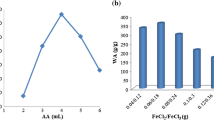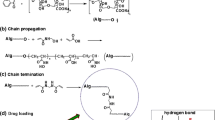Abstract
This paper reports the preparation and characterization of novel pH- and thermo-responsive blend hydrogel microspheres of sodium alginate (NaAlg) and poly(N-isopropylacrylamide)(PNIPAAm)-grafted-guar gum (GG) i.e., PNIPAAm-g-GG by emulsion cross-linking method using glutaraldehyde (GA) as a cross-linker. Isoniazid (INZ) was chosen as the model antituberculosis drug to achieve encapsulation up to 62%. INZ has a plasma half-life of 1.5 h, whose release was extended up to 12 h. Fourier transform infrared spectroscopy was used to confirm the grafting reaction and chemical stability of INZ during the encapsulation. Differential scanning calorimetry was used to investigate the drug’s physical state, while powder X-ray diffraction confirmed the molecular level dispersion of INZ in the matrix. Scanning electron microscopy confirmed varying surface morphologies of the drug-loaded microspheres. Temperature- and pH-responsive nature of the blend hydrogel microspheres were investigated by equilibrium swelling, and in vitro release experiments were performed in pH 1.2 and pH 7.4 buffer media at 37°C as well as at 25°C. Kinetics of INZ release was analyzed by Ritger–Peppas empirical equation to compute the diffusional exponent parameter (n), whose value ranged between 0.27 and 0.58, indicating the release of INZ follows a diffusion swelling controlled release mechanism.






Similar content being viewed by others
REFERENCES
Rudzinski WE, Aminabhavi TM. Chitosan as a carrier for targeted delivery of small interfering RNA. Int J Pharm. 2010;399(1–2):1–11.
El-Sherbiny IM. Enhanced pH-responsive carrier system based on alginate and chemically modified carboxymethyl chitosan for oral delivery of protein drugs: preparation and in-vitro assessment. Carbohydr polym. 2010;80(4):1125–36.
El-Leithy ES, Shaker DS, Ghorab MK, Abdel-Rashid RS. Evaluation of mucoadhesive hydrogels loaded with diclofenac sodium–chitosan microspheres for rectal administration. AAPS PharmSciTech. 2012;11(4):1695–702.
Kajjari PB, Manjeshwar LS, Aminabhavi TM. Semi-interpenetrating polymer network hydrogel blend microspheres of gelatin and hydroxyethyl cellulose for controlled release of theophylline. Ind Eng Chem Res. 2011;50(13):7833–40.
Peppas NA, Wood KM, Blanchette JO. Hydrogels for oral delivery of therapeutic proteins. Expert Opin Biol Ther. 2008;4(6):881–7.
Qiu Y, Park K. Environment-sensitive hydrogels for drug delivery. Adv Drug Deliv Rev. 2001;53(3):321–39.
Atta AM, Abdel-Bery EM, Rezk K, Abdel-Azim A. Fast responsive poly(acrylic acid-co-N-isopropylacrylamide) hydrogels based on new crosslinker. J Appl Polym Sci. 2009;112(1):114–22.
Kopeček J. Smart and genetically engineered biomaterials and drug delivery systems. Eur J Pharm Sci. 2003;20(1):1–16.
Mallikarjuna Reddy K, Ramesh Babu V, Krishna Rao KSV, Subha MCS, Chowdoji Rao K, Sairam M, Aminabhavi TM. Temperature sensitive semi-IPN microspheres from sodium alginate and N-isopropylacrylamide for controlled release of 5-fluorouracil. J Appl Polym Sci. 2008;107(5):2820–9.
Krishnaiah YS, Satyanarayana V, Dinesh Kumar B, Karthikeyan RS. In vitro drug release studies on guar gum-based colon targeted oral drug delivery systems of 5-fluorouracil. Eur J Pharm Sci. 2002;16(3):185–92.
Soppimath KS, Kulkarni AR, Aminabhavi TM. Chemically modified polyacrylamide-g-guar gum-based crosslinked anionic microgels as pH-sensitive drug delivery systems: preparation and characterization. J Control Release. 2001;75(5):331–45.
Zhang JT, Huang SW, Zhuo RX. Preparation and characterization of novel temperature sensitive poly(N-isopropylacrylamide-co-acryloyl beta-cyclodextrin) hydrogels with fast shrinking kinetics. Macromol Chem Phys. 2004;205(1):107–13.
Li X, Wu W, Liu W. Synthesis and properties of thermo-responsive guar gum/poly(N-isopropylacrylamide) interpenetrating polymer network hydrogels. Carbohydr Polym. 2008;71(3):394–402.
Zhang J, Peppas NA. Synthesis and characterization of pH- and temperature-sensitive poly(methacrylic acid)/poly(N-isopropylacrylamide) interpenetrating polymeric networks. Macromolecules. 2000;33(1):102–7.
Lang YY, Jiang TY, Li SM, Zheng LY. Study on physicochemical properties of thermosensitive hydrogels constructed using graft-copolymers of poly(N-isopropylacrylamide) and guar gum. J Appl Polym Sci. 2008;108(6):3473–9.
Zhang XZ, Zhang JT, Zhuo RX, Chu CC. Synthesis and properties of thermosensitive, crown ether incorporated poly(N-isopropylacrylamide) hydrogel. Polymer. 2002;43(17):4823–7.
Zhang JT, Cheng SX, Zhuo RX. Poly(vinyl alcohol)/poly(N-isopropylacrylamide) semi-interpenetrating polymer network hydrogels with rapid response to temperature changes. Colloid Polym Sci. 2003;281(6):580–3.
Rajesh N, Siddaramaiah. Feasibility of xanthan gum–sodium alginate as a transdermal drug delivery system for domperidone. J Mater Sci Mater Med. 2009;20(10):2085–9.
Agnihotri SA, Kulkarni RV, Nadagouda NM, Kulkarni PV, Aminabhavi TM. Electrically modulated transport of diclofenac salts through hydrogels of sodium alginate, carbopol, and their blend polymers. J Appl Polym Sci. 2005;96(2):301–11.
Hua S, Ma H, Li X, Yang H, Wang A. pH-sensitive sodium alginate/poly(vinyl alcohol) hydrogel beads prepared by combined Ca2+ crosslinking and freeze-thawing cycles for controlled release of diclofenac sodium. Int J Biol Macromol. 2010;46(5):517–23.
George M, Abraham TE. pH sensitive alginate–guar gum hydrogel for the controlled delivery of protein drugs. Int J Pharm. 2007;335(1–2):123–9.
Helen MI, Marianne W, Cedric JW, Gregory DH, Schaaf HS, Peter JS, Peter RD. Isoniazid plasma concentrations in a cohort of South African children with tuberculosis: implications for International Pediatric Dosing Guidelines. Clin Infect Dis. 2009;48(11):1547–53.
Pandey R, Khuller GK. Chemotherapeutic potential of alginate–chitosan microspheres as anti-tubercular drug carriers. J Antimicrob Chemother. 2004;53(4):635–40.
Angadi SC, Manjeshwar LS, Aminabhavi TM. Interpenetrating polymer network blend microspheres of chitosan and hydroxyethyl cellulose for controlled release of isoniazid. Int J Biol Macromol. 2010;47(2):171–9.
More SM, Kulkarni RV, Sa B, Kayane NV. Glutaraldehyde-crosslinked poly(vinyl alcohol) hydrogel discs for the controlled release of antidiabetic drug. J Appl Polym Sci. 2010;116(3):1732–8.
Petrusic S, Lewandowski M, Giraud S, Jovancic P, Bugarski B, Ostojic S, Koncar V. Development and characterization of thermosensitive hydrogels based on poly(N-isopropylacrylamide) and calcium alginate. J Appl Polym Sci. 2012;124(2):890–903.
Aykara TC, Demirci S, Eroğlu MS, Güven O. Poly(ethylene oxide) and its blends with sodium alginate. Polymer. 2005;46(24):10750–7.
Gunasekaran S, Sailatha E, Seshadri S, Kumaresan S. FTIR, FT Raman spectra and molecular structural confirmation of Isoniazid. Indian J Pure Appl Phys. 2009;47(1):12–8.
Korsmeyer RW, Lustig SR, Peppas NA. Solute and penetrant diffusion in swellable polymers. I. Mathematical modeling. J Polym Sci B Polym Phys. 1986;24(2):395–408.
Wang Q, Zhang J, Wang A. Preparation and characterization of a novel pH-sensitive chitosan-g-poly(acrylic acid)/attapulgite/sodium alginate composite hydrogel bead for controlled release of diclofenac sodium. Carbohydr polym. 2009;78(4):731–7.
ACKNOWLEDGMENT
The authors (Mr. P.B. Kajjari and Professor. L.S. Manjeshwar) thank the University Grants Commission (UGC), New Delhi, India (KU/SHA/UGC/RFSMS/2009-10), for a fellowship to P.B. Kajjari. Professor T. M. Aminabhavi thanks the All India Council for Technical Education, New Delhi [F.NO. 1-51/RIFD/EF(13)/2011-12] for Emeritus Fellowship.
Author information
Authors and Affiliations
Corresponding author
Rights and permissions
About this article
Cite this article
Kajjari, P.B., Manjeshwar, L.S. & Aminabhavi, T.M. Novel pH- and Temperature-Responsive Blend Hydrogel Microspheres of Sodium Alginate and PNIPAAm-g-GG for Controlled Release of Isoniazid. AAPS PharmSciTech 13, 1147–1157 (2012). https://doi.org/10.1208/s12249-012-9838-8
Received:
Accepted:
Published:
Issue Date:
DOI: https://doi.org/10.1208/s12249-012-9838-8




